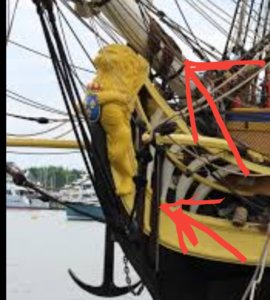-

Win a Free Custom Engraved Brass Coin!!!
As a way to introduce our brass coins to the community, we will raffle off a free coin during the month of August. Follow link ABOVE for instructions for entering.
You are using an out of date browser. It may not display this or other websites correctly.
You should upgrade or use an alternative browser.
You should upgrade or use an alternative browser.
Hello Messis.
This is called Gammoning (gammoning-rope). Until into 19th century double rope lashing, then chain where used.
GAMMONING. Nine or eleven turns of the rope are passed over the bowsprit and through a hole cut in the knee of the head alternately; (but, where there is no knee, through a large triangular ring-bolt driven through the stem.) The first end is whipt and passed through the hole, and over the bowsprit, with a round turn, then clinched round the bowsprit close against the cleats; the other end passes through the fore-part of the hole, taking care to cross every turn, and keep each turn forward on the bowsprit, and aft in the hole, and every turn is hove tight and nipper'd. In the navy, the bowsprit is first heaved down by a chain-boat. A selvage is fastened round the bowsprit next the saddle, for the spritsail-slings, to which a block is hooked, and through it a pendent is reeved, having one end made fast to an eye-bolt in one side the boat, and a lulff-tackle to the other end, whose fall is connected with the windlass, and heaved tight by hand specs; the fall is then stopped with spunyarn, and taken off the windlass. Each turn of the gammoning rope is then heaved tight as above. A leading block is lashed through an eye-bolt, in the bow of the chain-boat, or round the davit, and a pendent reeved through, with an eye spliced in one end, through which a bight of the gammoning-rope is passed, and retained by means of a toggle. To the other end of the pendent is hooked a luff-tackle, whose fall is connected with the windlass, and heaved tight as before. The luff-tackle is over-hauled by a small jigger-tackle, made fast to the davit-head and strap of the luff-tackle block. In merchant-ships, chain-boats are seldom used. Their own long-boats or casks of water are heaved up to the bowsprit end, and every turn of the gammoning-rope is connected with the windlass or capstern, on-board. A leading block is made fast through the holes, for the bob-stay, with tails, long enough for the pendent and tackle, to lead straight through the hawser-holes to the windlass. The process as before.
When all the turns are passed and hove tight, they are frapped together in the middle, by as many cross turns as are passed over the bowsprit, each turn hove tight: the end of the gammoning rope is then whipt, and seized to one of the turns. The frapping increases the tension, and adds to the security acquired by the purchase.
 en.wiktionary.org
en.wiktionary.org
 maritime.org
maritime.org
hope this will help, Happy modeling
This is called Gammoning (gammoning-rope). Until into 19th century double rope lashing, then chain where used.
GAMMONING. Nine or eleven turns of the rope are passed over the bowsprit and through a hole cut in the knee of the head alternately; (but, where there is no knee, through a large triangular ring-bolt driven through the stem.) The first end is whipt and passed through the hole, and over the bowsprit, with a round turn, then clinched round the bowsprit close against the cleats; the other end passes through the fore-part of the hole, taking care to cross every turn, and keep each turn forward on the bowsprit, and aft in the hole, and every turn is hove tight and nipper'd. In the navy, the bowsprit is first heaved down by a chain-boat. A selvage is fastened round the bowsprit next the saddle, for the spritsail-slings, to which a block is hooked, and through it a pendent is reeved, having one end made fast to an eye-bolt in one side the boat, and a lulff-tackle to the other end, whose fall is connected with the windlass, and heaved tight by hand specs; the fall is then stopped with spunyarn, and taken off the windlass. Each turn of the gammoning rope is then heaved tight as above. A leading block is lashed through an eye-bolt, in the bow of the chain-boat, or round the davit, and a pendent reeved through, with an eye spliced in one end, through which a bight of the gammoning-rope is passed, and retained by means of a toggle. To the other end of the pendent is hooked a luff-tackle, whose fall is connected with the windlass, and heaved tight as before. The luff-tackle is over-hauled by a small jigger-tackle, made fast to the davit-head and strap of the luff-tackle block. In merchant-ships, chain-boats are seldom used. Their own long-boats or casks of water are heaved up to the bowsprit end, and every turn of the gammoning-rope is connected with the windlass or capstern, on-board. A leading block is made fast through the holes, for the bob-stay, with tails, long enough for the pendent and tackle, to lead straight through the hawser-holes to the windlass. The process as before.
When all the turns are passed and hove tight, they are frapped together in the middle, by as many cross turns as are passed over the bowsprit, each turn hove tight: the end of the gammoning rope is then whipt, and seized to one of the turns. The frapping increases the tension, and adds to the security acquired by the purchase.
gammoning - Wiktionary, the free dictionary
The Elements and Practice of Rigging And Seamanship
hope this will help, Happy modeling



